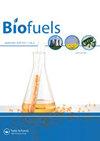NaCl stress mediated lipid and carotenoid production in freshwater microalga Kirchneriella obesa by optimization of medium composition using response surface methodology
IF 2.6
4区 工程技术
Q3 ENERGY & FUELS
引用次数: 0
Abstract
Abstract Optimal nitrate, phosphate and salinity for maximal biomass, lipid and carotenoid content of the freshwater microalga Kirchneriella obesa were investigated by using Box-Behnken Design. In an optimised condition, these three factors enhanced biomass production by 0.64 g/L more than the control (0.25 g/L). At 2.5 g/L nitrate, 0.04 g/L phosphate, and 25 mM NaCl, the maximum lipid accumulation (46.02%) and carotenoid content (2.58 mg/L) were achieved. The fit of the model yielded R2 values of up to 0.9955 for biomass, 0.9984 for lipids and 0.9999 for carotenoid, respectively. For the highest carbohydrate (418.28 mg/L) content, the medium was supplemented with 1.5 g/L nitrate, 0.04 g/L phosphate, and 40 mM NaCl. While the highest protein content (320.53 mg/L) was attributed to the medium with 3 g/L nitrate, 0.02 g/L phosphate and 25 mM NaCl. The major fatty acid compositions found in this algae were C18:1trans (16.36 ± 1.4), C18:1cis (6.001 ± 0.44), C18:2 (8.32 ± 1.1) and C18:3 (34.39 ± 2.3%), demonstrating their importance in biofuel production and human health.响应面法优化培养基组成研究NaCl胁迫介导淡水微藻油脂和类胡萝卜素的产生
摘要采用Box-Behnken设计研究了淡水微藻(Kirchneriella obesa)生物量、脂质和类胡萝卜素含量最大的最佳硝酸盐、磷酸盐和盐度。在优化条件下,这三个因素使生物量产量比对照(0.25 g/L)提高了0.64 g/L。在2.5 g/L硝酸盐、0.04 g/L磷酸盐和25 mM NaCl处理下,脂质积累达到46.02%,类胡萝卜素含量达到2.58 mg/L。生物量、脂类和类胡萝卜素的拟合R2分别高达0.9955、0.9984和0.9999。当培养基中添加1.5 g/L硝酸盐、0.04 g/L磷酸盐和40 mM NaCl时,碳水化合物含量最高(418.28 mg/L)。在硝酸盐浓度为3 g/L、磷酸盐浓度为0.02 g/L、NaCl浓度为25 mM的培养基中,蛋白质含量最高,为320.53 mg/L。该藻类的主要脂肪酸组成为C18:1trans(16.36±1.4)、C18:1cis(6.001±0.44)、C18:2(8.32±1.1)和C18:3(34.39±2.3%),表明其在生物燃料生产和人类健康中的重要性。
本文章由计算机程序翻译,如有差异,请以英文原文为准。
求助全文
约1分钟内获得全文
求助全文
来源期刊

Biofuels-Uk
Energy-Renewable Energy, Sustainability and the Environment
CiteScore
5.40
自引率
9.50%
发文量
56
期刊介绍:
Current energy systems need a vast transformation to meet the key demands of the 21st century: reduced environmental impact, economic viability and efficiency. An essential part of this energy revolution is bioenergy.
The movement towards widespread implementation of first generation biofuels is still in its infancy, requiring continued evaluation and improvement to be fully realised. Problems with current bioenergy strategies, for example competition over land use for food crops, do not yet have satisfactory solutions. The second generation of biofuels, based around cellulosic ethanol, are now in development and are opening up new possibilities for future energy generation. Recent advances in genetics have pioneered research into designer fuels and sources such as algae have been revealed as untapped bioenergy resources.
As global energy requirements change and grow, it is crucial that all aspects of the bioenergy production process are streamlined and improved, from the design of more efficient biorefineries to research into biohydrogen as an energy carrier. Current energy infrastructures need to be adapted and changed to fulfil the promises of biomass for power generation.
Biofuels provides a forum for all stakeholders in the bioenergy sector, featuring review articles, original research, commentaries, news, research and development spotlights, interviews with key opinion leaders and much more, with a view to establishing an international community of bioenergy communication.
As biofuel research continues at an unprecedented rate, the development of new feedstocks and improvements in bioenergy production processes provide the key to the transformation of biomass into a global energy resource. With the twin threats of climate change and depleted fossil fuel reserves looming, it is vitally important that research communities are mobilized to fully realize the potential of bioenergy.
 求助内容:
求助内容: 应助结果提醒方式:
应助结果提醒方式:


